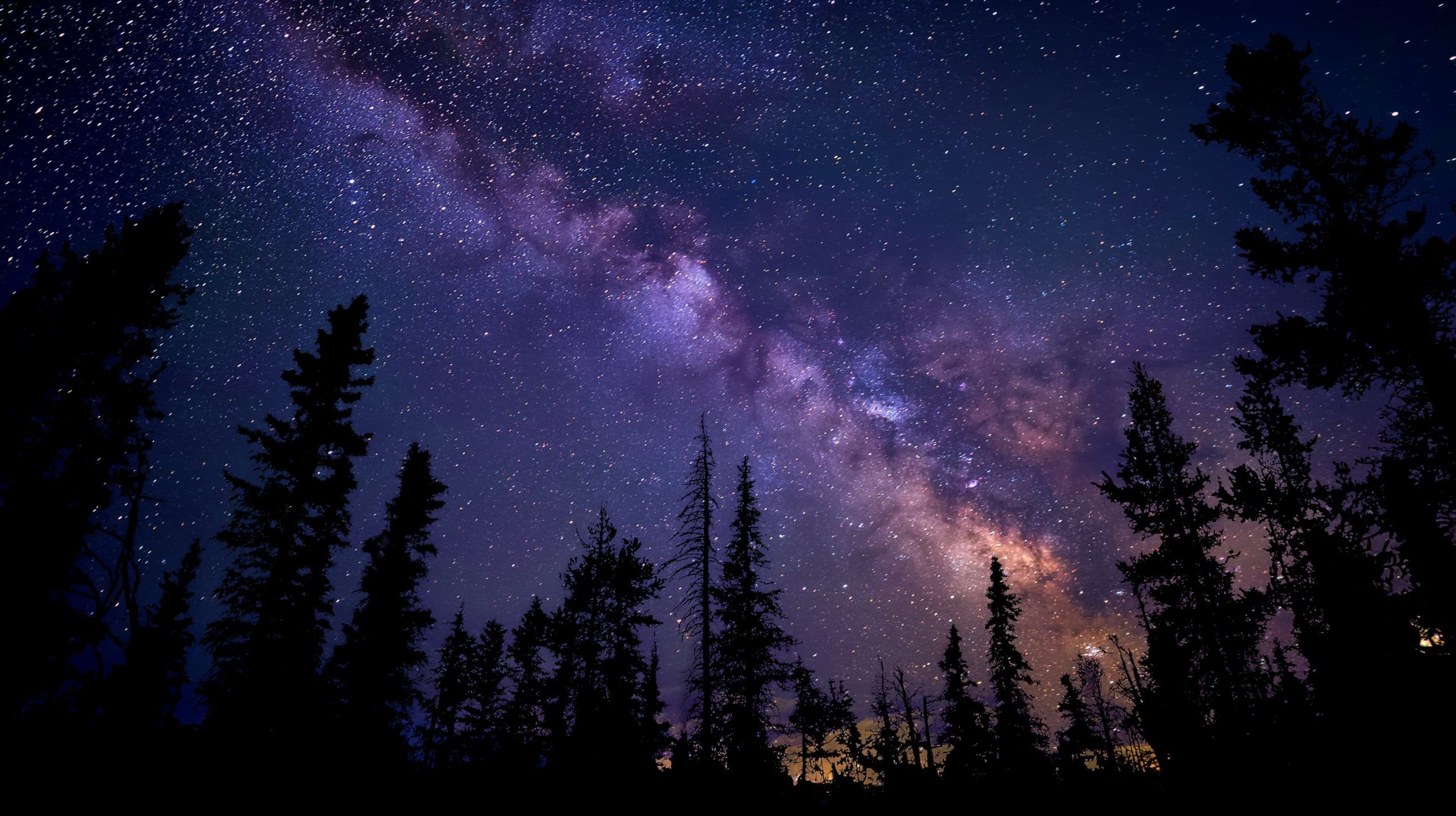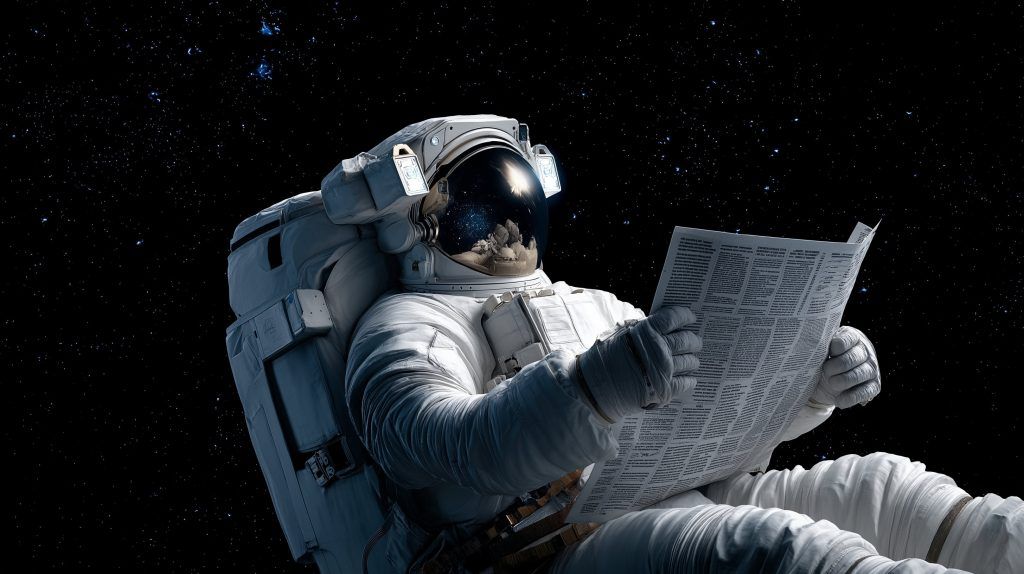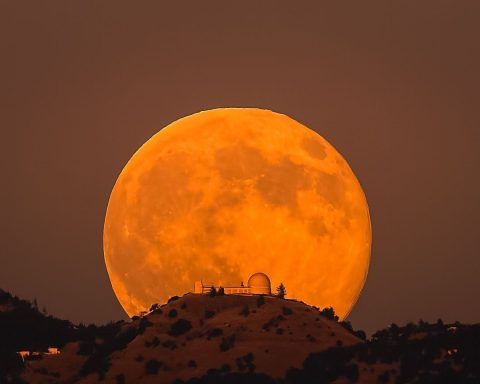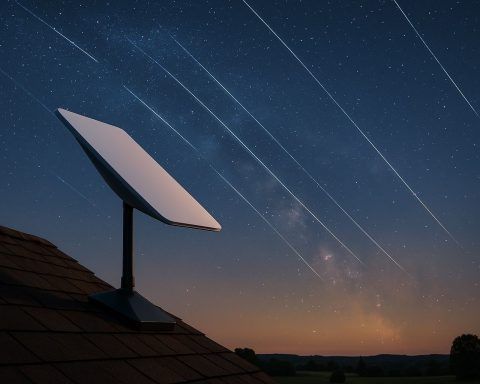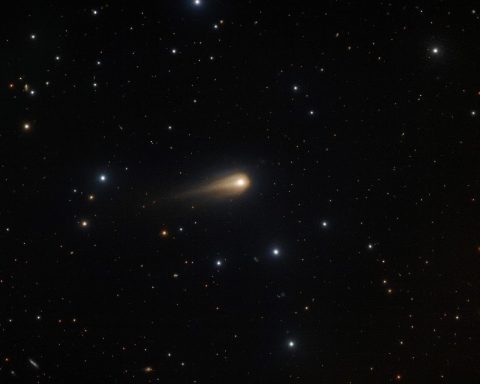Key Skywatch Highlights (October 6–7, 2025):
- Brilliant Harvest Supermoon: A full “Harvest Moon” – also the year’s first supermoon – rises on Oct. 6, appearing about 30% brighter and 14% larger than a typical full moon at perigee [1]. Peak illumination occurs around 3:48 UTC on Oct. 7 (late Oct. 6 in the Americas) [2].
- Moon & Saturn Pairing: The nearly full moon shines close to Saturn on the nights of Oct. 5–6 [3]. Saturn, just past opposition in late September, is visible all night, golden in the southeast after sunset. Venus and Jupiter meanwhile sparkle as morning “stars” before dawn [4].
- Draconid Meteor Shower: The Draconids are active Oct. 6–10 (peaking around Oct. 8) as Earth passes through debris of comet 21P/Giacobini-Zinner [5]. Under ideal dark skies up to ~10 meteors/hour might be seen [6], but the bright moonlight will wash out many of these normally faint shooting stars [7].
- Aurora Alerts: Minor geomagnetic storming (G1–G2 level) is possible Oct. 6–8 if recent solar eruptions arrive [8]. High-latitude skywatchers could glimpse aurora borealis/australis. Earlier this week, a surprise G3 storm lit up skies as far south as New York [9], so continued unsettled space weather keeps aurora watchers on alert.
- Viewing Tips: For the supermoon, simply look east at sunset on Oct. 6 to watch a gigantic amber moon rising [10]. For meteors and auroras, seek dark skies away from city lights after nightfall. Block the moon with your hand or a building to improve meteor visibility [11] [12]. Check local forecasts – clear, cloud-free skies are essential – and monitor aurora alerts (Kp index) if you’re in aurora-visible latitudes. Bring warm clothes and a comfy chair for a long gaze upward!
The Harvest Supermoon of October 6–7, 2025
Illustration: A comparison of a supermoon at perigee vs. a micromoon at apogee, as seen from Earth. The Oct. 6 full moon occurs near lunar perigee, making it a supermoon (larger and brighter than average) [13]. NASA/JPL-Caltech.
October’s full moon arrives on the night of October 6–7 and is extra special: it’s both the Harvest Moon and a Supermoon. The term Harvest Moon refers to the full moon closest to the autumnal equinox (Sept. 22), traditionally aiding farmers with extended evening light [14]. In 2025, the September full moon fell early in the month, so this October full moon earns the “Harvest” title [15]. It reaches 100% illumination at 03:47 UTC on Oct. 7 (11:47 p.m. EDT Oct. 6) [16], and will be visible all night as a beacon in the sky.
What makes this moon a supermoon is its closeness to Earth. The Moon’s orbit is slightly elliptical, and on Oct. 6 it swings to about 224,600 miles from Earth – significantly nearer than its ~238,900-mile average distance [17]. According to NASA, this will make the full moon appear roughly 30% brighter and 14% larger than usual [18]. In NASA’s words: “The evening of October 6, look up and be amazed as the full moon is bigger and brighter because – it’s a supermoon!” [19]. Many observers will notice the moon looking especially big and golden at moonrise, an optical illusion enhanced by its low horizon position.
Beyond its beauty, this Super Harvest Moon has real effects. Its extra gravitational tug contributes to higher-than-normal tides, often called “king tides.” In fact, meteorologists warn of minor coastal flooding in some areas due to the full moon’s influence on tidal waters, with peak high tides occurring just after the full moon midweek [20]. If you live along a coast, be aware of strong tidal currents and any local advisories.
Viewing the Supermoon: Fortunately, you don’t need any special equipment – just look up! The moon rises around local sunset on Oct. 6, so catch it looming large on the eastern horizon at dusk [21]. It will climb high through the night and set near sunrise on Oct. 7. Binoculars or a small telescope will reveal lunar seas and craters in detail (though the intense brightness may require a moon filter or lightly tinted glasses for comfort). Because this moon is so bright, it outshines most stars – making deep-sky stargazing tough this night – but it provides a great opportunity to observe lunar features and even nearby planets. Saturn, shining at magnitude ~0.5, will be one of the few “stars” visible near the moon’s glare. If you point a telescope at Saturn, you can admire its rings (now tilted nearly edge-on) and maybe even a few moons, though the moon’s brilliance may reduce contrast.
Moon Meets Saturn, Jupiter Rises Late
Skywatchers on Oct. 5–6 will notice a pretty conjunction: the almost-full Moon “meets up” with Saturn in the evening sky [22]. On Oct. 6, the duo is only a few degrees apart, making Saturn easy to locate – it’s the steady, golden point of light near the glaring Moon. Saturn reached opposition (when Earth lay between Saturn and the Sun) in late September, so it remains big and bright, visible all night in the constellation Aquarius. Although the proximity of the dazzling Moon might wash out Saturn a bit, you can still observe Saturn with a telescope; it will be to the moon’s upper right as they rise in the east at sunset (for mid-northern latitudes). By midnight, the Moon-Saturn pair will be high in the south. In addition, the star Fomalhaut (in Pisces Austrinus) twinkles not far below them, offering a reminder of autumn’s star patterns [23].
Elsewhere in the sky, Jupiter and Venus are the planets to watch for, though not during the early evening. Jupiter becomes visible later at night – rising in the east by late evening (it will reach its own opposition in November, growing brighter each week). Venus, on the other hand, is currently a brilliant morning star. Early risers can spot Venus low in the east before and during dawn, outshining everything except the Moon. Mars and Mercury are not prominent now – they’re lurking low in the bright evening twilight and will be very difficult to see. (Mercury will reach a greatest elongation later in the month on Oct. 29, becoming briefly more observable in the Southern Hemisphere’s evening sky [24].) For October 6–7, your planetary highlights are Saturn alongside the Moon, Jupiter emerging after midnight, and Venus greeting the sunrise [25].
Pro tip: If you’re trying to identify Saturn next to the full Moon, note that Saturn doesn’t twinkle like a star – its light is steadier. Also, if you have clear skies on Oct. 6, you can watch the Moon’s movement relative to Saturn over hours – the moon will drift eastward (leftward) in its orbit, widening the separation slightly by the next night. It’s a nice demonstration of the moon’s motion against the background sky.
Draconid Meteor Shower – Dragons in the Moonlight
Sky map: The Draconid meteor shower’s radiant (apparent origin point) lies near the head of Draco in the northwest evening sky, not far from the bright star Vega and planet Saturn. The green markers indicate the meteor paths emanating from Draco [26]. In 2025, a bright moon in the southeast will hinder visibility, but a few “dragon” meteors may still streak across the sky.
Each October, Earth crosses the orbital path of Comet 21P/Giacobini–Zinner, and the comet’s dusty debris gives rise to the Draconid meteor shower. This shower is a bit of an oddball. Unlike most meteor showers that are best after midnight, the Draconids radiate from the head of the constellation Draco – which is highest in the sky in the evening hours during early October [27]. That means the evenings of Oct. 6–10 (especially Oct. 7–8) are prime time to watch for Draconid “shooting stars” flitting overhead.
What to Expect: In most years, the Draconids are a minor shower – a “sleeping dragon.” Under a truly dark sky with no moon, one might catch at most 5–10 meteors per hour at the peak [28] [29]. The meteors tend to be slow-moving but can be colorful. However, this year the moon is nearly full during the shower’s peak (Oct. 8), which is bad news for meteor watchers. Bright moonlight will overwhelm faint meteors, potentially limiting visible rates to just a few per hour at best [30]. NASA bluntly notes that if you don’t see any Draconids, you can “blame the bright supermoon” flooding the sky with light [31]!
That said, the Draconids are famous for occasionally waking up in a fiery fury. Rare outbursts have occurred when Earth passes through especially dense clumps of comet debris – past Draconid storms have produced hundreds or even thousands of meteors per hour (notably in 1933 and 1946) [32]. In more recent history, a strong outburst in 2011 wowed skywatchers over Europe with over 600 meteors per hour. Such events are unpredictable but tend to happen when the comet has made a recent close approach to the Sun. Coincidentally, Comet 21P returned to perihelion (closest point to Sun) in March 2025 [33]. Does that mean a Draconid surprise could occur this year? Possibly, say experts [34] [35], but nothing is guaranteed. Most forecasts did not predict a major storm for 2025 – so assume a quiet show, but keep an eye out just in case the Dragon roars to life.
How and When to Watch: The Draconid radiant is near the stars Eltanin and Rastaban (the Dragon’s “Eyes”) in the head of Draco [36], which in early October evenings is high in the northwest for mid-northern latitudes. That makes the early evening through mid-night the best time. As night progresses, Draco sinks lower, so late-night Draconids are fewer. If you’re in the Northern Hemisphere, face northwest and scan the sky – though meteors can appear anywhere, not just near Draco. Viewers in the Southern Hemisphere will have a much tougher time; Draco is very low or below the horizon, so Draconids are rarely seen from far-south latitudes [37].
To improve your odds, get away from city lights and try to find a patch of sky not directly exposed to the moon. You might position yourself so that a building, hill, or trees block the bright Moon (which will be in the east/southeast during the evening). Allow your eyes 20–30 minutes to adapt to the dark. No telescopes or binoculars are needed – meteors are fast and streak across wide portions of sky. Just lie back on a lawn chair or blanket, watch, and be patient. You may only catch a handful of meteors, but each “shooting star” you do see is a tiny bit of comet dust burning up ~60 miles overhead – essentially comet litter hitting Earth’s atmosphere. If you do spot any Draconids, you’ll be witnessing a piece of Halley’s Comet’s less-famous cousin meeting a fiery end! And if the Dragon stays dormant this year, don’t fret: later this month the Orionid meteor shower (from Halley’s Comet) will peak under moonless dark skies around Oct. 21 with a far better show expected [38].
Fun fact: The Draconids are sometimes called the Giacobinids, after Michel Giacobini, who co-discovered the parent comet in 1900. The comet has a 6.6-year orbit that periodically brings fresh debris into Earth’s path [39]. When it does, meteor rates can increase. So even if 2025’s display is modest, the potential for a dragon storm is part of the Draconids’ allure, keeping avid meteor observers outside just in case “the Dragon awakes” [40].
Aurora Watch: Solar Storms & Northern Lights Outlook
In addition to the lunar and meteor drama, skywatchers should keep tabs on the aurora borealis (and australis) on Oct. 6–7. We are near the peak of Solar Cycle 25, and the Sun has been feisty lately – sending high-speed solar wind and flares our way. Earlier this week, a surprise geomagnetic storm (triggered by a coronal hole stream) sparked dazzling auroras across Europe and North America, reaching as far south as New York and Wisconsin on the night of Oct. 1 [41] [42]. That storm hit G3 (Strong) levels, catching many by surprise with vivid lights dancing over a dozen U.S. states. Since then, the Earth’s magnetic field has been unsettled but calming as that initial disturbance faded [43].
Now attention turns to a couple of new solar eruptions that happened on October 3. Space weather forecasters at NOAA observed two slow-moving coronal mass ejections (CMEs) that may be en route to Earth [44]. These blobs of charged solar plasma are expected to brush past Earth sometime around Oct. 6–8. According to NOAA’s Space Weather Prediction Center, this could lead to G1–G2 geomagnetic storm conditions (minor to moderate storms) if one or both CMEs indeed arrive [45]. In its forecast, NOAA noted “Oct 6–8: Unsettled to active levels are expected, with possible G1–G2 (Minor–Moderate) geomagnetic storms if one or both slow CMEs from October 3 arrive.” [46]. There’s even a slight chance (albeit low) that a stronger G3-level event could occur if the impact is greater than anticipated [47], but at this point a mild disturbance is the safer bet.
What this means for aurora seekers: If the forecast holds, high-latitude regions have a decent shot at auroras on the nights of Oct. 6, 7, and/or 8. This includes locations like Scandinavia, Iceland, Greenland, Canada, Alaska, and possibly the northern border-tier of the contiguous U.S. (think Washington, Montana, North Dakota, Minnesota, Michigan, upstate New York, Maine) as well as southernmost parts of New Zealand and Tasmania in the Southern Hemisphere. Under a G1–G2 storm, the auroral oval could expand enough that auroras “could be visible across a wide swath of the northern U.S.” (especially under dark skies with little light pollution) [48]. If a stronger burst (G3) were to materialize, the lights could dip even farther south – but again, that is only a remote possibility at this time [49].
Peak geomagnetic activity often occurs near local midnight (between 10 p.m. and 2 a.m. local time), but auroras can appear anytime it’s dark if conditions are right. On Oct. 6–7, the nearly full moon will be a factor – its light can make faint auroras harder to see, much as it does with meteors. Nonetheless, vivid auroras (especially those with movement and pillars) can still be visible to the eye even under moonlight, particularly if they are directly overhead or to the north (for northern hemisphere observers). Auroras may appear as greenish glows or pulsating curtains; sometimes red or purple fringes show up if the storm is strong. Aurora australis (southern lights) would similarly glow in southern polar latitudes, but note that in the Southern Hemisphere, early October’s nights are shorter (springtime) and populated areas (like in Australia) are fairly far from the magnetic pole, so sightings are more challenging unless the storm is strong.
Tips for Aurora Viewing: First, you’ll want to be as far north (or south, for australis) as possible within the auroral zone and have a clear, dark sky. Get away from city lights – even a moderate aurora can be drowned out by urban light pollution or moonlight. Face the magnetic pole (north for northern lights; south for southern) and watch the sky about 10–20 degrees above the horizon up to overhead. Patience is key; auroral activity can ebb and flow on timescales of minutes. Keep checking NOAA’s Kp index or aurora forecast tools – a Kp of 5 corresponds to G1 storm (auroras likely in Canada/northern U.S.), Kp 6–7 for G2 (auroras into more U.S. states, possibly UK, Germany, etc.), and Kp 7–8+ for major storms reaching further [50] [51]. Even if the official forecast is for only G1, stay alert: the Oct 1 event showed that geomagnetic predictions aren’t always exact, and the aurora can overperform expectations.
Dress warmly (those clear autumn nights can get chilly), and give your eyes time to adjust to the dark. You might initially discern a diffuse greyish cloud or smoke-like shape – that often turns out to be aurora when viewed on a long-exposure photo or as your eyes acclimate. If you’re keen on capturing the aurora with a camera, use a tripod and a high ISO with a multi-second exposure. Many auroral displays start as a diffuse glow and then erupt into shimmering curtains or “dancing” rays, so don’t pack up too early. And importantly, manage expectations: auroras aren’t guaranteed. If the CMEs miss Earth or the solar wind alignment is unfavorable, you might see nothing at all. But if Lady Aurora does grace the sky, even a modest display can be breathtaking – a tangible reminder that our planet is directly connected to the Sun’s activity 93 million miles away.
Finally, a safety note: unlike eclipse-chasing, aurora viewing carries no risk to your eyes – so enjoy the show with wonder! The only hazard might be losing track of time while you gaze upward, or stumbling in the dark; use red light headlamps and stay aware of your surroundings, especially in cold remote locations.
Expert Insights and Viewing Advice
To make the most of these sky events, heed the advice of astronomers and experienced skywatchers:
- On the Supermoon: “This evening, the moon could appear to be about 30% brighter and up to 14% larger than a typical full moon,” NASA notes, due to the Moon being at its closest for the month [52]. While the supermoon’s brilliance will drown out faint stars, it’s a great opportunity to explore lunar terrain. Tip: Use binoculars to scan along the moon’s terminator (the day-night line) where shadows enhance the craters and mountains. And if you’re into photography, try shooting the rising moon with foreground landmarks for a dramatic composition – just be sure to use a fast exposure to avoid overexposing the lunar disk.
- Meteor Shower Etiquette: The Draconids may be subtle this year, but as EarthSky’s experts remind, “if you don’t see any, you can always blame the bright supermoon” [53]. Meteor observing requires darkness and patience. Don’t use telescopes or binoculars – they restrict your view. Instead, get comfortable lying back and watch as much sky as possible. Give your eyes time to adapt (avoid looking at your phone or any lights). If the moon is too intense, placing yourself in a moon-shadow (on the north side of a building, for instance) can help. Crucially, manage expectations: Bruce McClure of EarthSky calls the Draconids a “sleeper” shower that usually produces only a handful of meteors per hour [54]. But he also warns that this shower “keeps many skywatchers outside – even in moonlight – during this shower” on the rare chance the “fiery Dragon” awakes with an outburst [55]. So, it’s up to you whether to spend time dragon-hunting; even a single meteor can be rewarding if it streaks past the glowing moon!
- Aurora Forecasting: NOAA and other space-weather scientists emphasize the uncertainty in timing and intensity of auroras. As noted, minor geomagnetic storms are on watch for Oct. 6–7 [56], but whether auroras materialize depends on factors like the magnetic orientation of the solar wind upon arrival. Astrophysicist C. Gohd at NASA’s JPL points out that we’re in the equinox season, which often boosts geomagnetic activity due to the Earth’s tilt [57]. This means auroras can easily surprise us around this time of year. Advice: if you live in a latitude that occasionally sees auroras (for example, northern U.S./Europe or southern Australia/NZ), it’s worth scanning the sky after dark on these nights. You might see a faint green glow on the horizon – a hint of aurora. The Kp index updates from SWPC (NOAA Space Weather Prediction Center) are a useful guide: Kp 5 or above means start looking! Even a Kp 4 (active conditions) can bring auroras into view in Canada or northern Scotland under clear, dark skies [58] [59].
- Weather Considerations: Of course, all these celestial sights require clear weather. Check your local forecast – early October can bring autumn frontal systems and clouds, especially in the mid-latitudes. If your area is expecting rain or overcast skies on Oct. 6–7, you may need to travel or resign to catching events online. Many observatories and astro-websites host live streams for major events (though the Draconids and auroras are harder to live-stream reliably). As one meteorologist quips, “the only thing no skywatcher can control is the clouds.” If you do have clear skies, take advantage!
- Eye Safety and Equipment: No special filters or glasses are needed for the full moon – unlike the sun, the moon’s light won’t damage your eyes. However, its brightness can be uncomfortable for some when viewed through telescopes; a simple lunar filter or even sunglasses can reduce glare. For auroras and meteors, dark adaptation is key – avoid any white light use. A red flashlight is ideal for preserving your night vision. Bring a reclining chair or sleeping bag so you can look up comfortably for extended periods. And consider a thermos of something warm; skywatching on cool October nights can get chilly, as you’ll often be sitting still for hours.
- Why These Events Matter: Beyond their sheer beauty, celestial events connect us to larger natural cycles. The Harvest Moon is a reminder of how farmers relied on the moon’s light – a synergy between celestial mechanics and human life [60]. Meteor showers like the Draconids and Orionids show us Earth’s path intersecting with remnants of ancient comets, literally bringing pieces of other worlds into our sky (albeit fleetingly as they burn up). Auroras demonstrate Earth’s magnetic field in action, shielding us from solar particles while painting the sky with ghostly lights – a visible manifestation of space weather. As NASA science communicator Chelsea Gohd puts it, these skywatching moments “inspire the world through discovery”, uniting casual observers and seasoned astronomers alike in looking up in wonder.
Official Alerts & Resources
Both NASA and NOAA have been actively alerting the public to this week’s sky events. NASA’s “What’s Up for October 2025” bulletin highlighted the “supermoon taking over the sky” and the Draconids “peeking through” despite the moonlight [61] [62]. NASA’s outreach suggests participating in events like International Observe the Moon Night (held Oct. 4) to share in the lunar enthusiasm [63]. The agency also provides online tools – e.g. the [Moon Phase and Daily Sky Guide] [64] – to help plan your observing. Meanwhile, NOAA’s Space Weather Prediction Center issued a geomagnetic storm watch for early October, and continues to monitor the incoming solar wind. Aurora enthusiasts can use NOAA’s Aurora Dashboard for near-real-time oval predictions, or the University of Alaska’s Geophysical Institute forecasts which indicated moderate aurora activity Oct. 5 and potentially Oct. 6 (with Kp 3–4 expected). Keep an eye on official channels like NASA Sun & Space and NOAA SWPC on social media for any updates – if a geomagnetic storm materializes, they often post alerts (and sometimes aurora photos from observers).
Lastly, for those keen on educational context, NASA and others have plenty of resources. Curious why auroras tend to ramp up around equinox? It’s related to something called the Russell-McPherron effect – essentially Earth’s tilt aligning just right for more solar particles to connect with our magnetosphere [65]. Want to know more about the Draconids’ parent comet? It was actually visited by a spacecraft: in 1985, the International Cometary Explorer (ICE) flew through Giacobini-Zinner’s tail, the first probe to encounter a comet. And the Harvest Moon lore spans cultures – for instance, in East Asia the Harvest Moon is celebrated as a festival (Mid-Autumn Festival), when families admire the bright moon and give thanks. Every one of these sky events is a chance to learn about orbital mechanics, solar-terrestrial physics, and our cultural heritage connected to the night sky.
In Summary: The nights of October 6–7, 2025, offer a cosmic cornucopia – a brilliant full supermoon lighting the sky, a subtle drizzle of comet dust in the form of Draconid meteors, and the tantalizing possibility of auroral glows on the horizon. Whether you’re an expert astronomer or a casual stargazer, take a moment to step outside and look up. As the saying goes, the night sky is the world’s oldest storyteller. This week’s chapter features a Moon at its closest, dragons breathing meteors, and solar winds painting the poles green. Don’t miss the show – and clear skies!
Sources: Official NASA skywatching guide [66] [67] [68]; TimeandDate astronomy calendar [69] [70]; EarthSky.org reports by Deborah Byrd, Bruce McClure, et al. [71] [72] [73]; Space.com and NOAA SWPC aurora alerts [74] [75]; Fox Weather and ABC News coverage of the Oct. supermoon [76] [77]. All information is current as of early October 2025. Enjoy your skywatching!
References
1. science.nasa.gov, 2. earthsky.org, 3. www.timeanddate.com, 4. earthsky.org, 5. science.nasa.gov, 6. science.nasa.gov, 7. www.timeanddate.com, 8. earthsky.org, 9. www.space.com, 10. earthsky.org, 11. earthsky.org, 12. earthsky.org, 13. science.nasa.gov, 14. www.timeanddate.com, 15. earthsky.org, 16. earthsky.org, 17. www.foxweather.com, 18. science.nasa.gov, 19. science.nasa.gov, 20. www.foxweather.com, 21. earthsky.org, 22. www.timeanddate.com, 23. earthsky.org, 24. earthsky.org, 25. earthsky.org, 26. science.nasa.gov, 27. earthsky.org, 28. earthsky.org, 29. science.nasa.gov, 30. www.timeanddate.com, 31. science.nasa.gov, 32. earthsky.org, 33. earthsky.org, 34. earthsky.org, 35. earthsky.org, 36. earthsky.org, 37. earthsky.org, 38. science.nasa.gov, 39. earthsky.org, 40. earthsky.org, 41. www.space.com, 42. www.space.com, 43. earthsky.org, 44. earthsky.org, 45. earthsky.org, 46. earthsky.org, 47. earthsky.org, 48. www.space.com, 49. www.space.com, 50. www.space.com, 51. www.space.com, 52. science.nasa.gov, 53. science.nasa.gov, 54. earthsky.org, 55. earthsky.org, 56. earthsky.org, 57. earthsky.org, 58. earthsky.org, 59. earthsky.org, 60. www.timeanddate.com, 61. science.nasa.gov, 62. science.nasa.gov, 63. science.nasa.gov, 64. www.timeanddate.com, 65. earthsky.org, 66. science.nasa.gov, 67. science.nasa.gov, 68. science.nasa.gov, 69. www.timeanddate.com, 70. www.timeanddate.com, 71. earthsky.org, 72. earthsky.org, 73. earthsky.org, 74. www.space.com, 75. www.space.com, 76. www.foxweather.com, 77. abcnews.go.com
